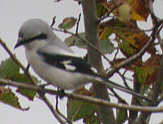Last updated 19:30 on October 31st

Ring Ouzel - Gunton - October 2002 - Robert Wincup
RED-THROATED
DIVER Gavia stellata
Corton - 5th (11 N, 2 S), 6th (20 N, 4 S).
Ness Point - 6th (10 N).
Kessingland - 1st (1 S, 2 o.s), 2nd (1 N, 5 o.s.), 3rd (5
N, 1 S), 4th (5 N, 7 S), 5th (11 N, 6 S, 1 o.s.), 6th (10 N, 8 S), 7th
(13 N, 8 S), 8th (5 N, 4 S), 9th (3 N, 1 S), 10th (1 N, 1 o.s.), 11th
(2 N), 12th (4 N, 1 S), 13th (4 N, 1 S), 14th (2 N), 15th (1 S), 16th
(4 S), 17th (5 N, 4 S), 18th (1 N, 1 S), 19th (2 N, 4 S), 20th (3 N,
1 S), 21st (2 N), 22nd (3 N), 23rd (10 N, 3 S), 24th (9 N, 8 S, 1 o/s),
25th (2 N, 2 S), 26th (3 S), 27th (3 N, 1 S), 28th (2 N), 29th (7 N,
2 S), 30th (8 N, 5 S), 31st (8 N, 7 S).
BLACK-THROATED DIVER Gavia arctica
Singles flew north past Kessingland on the 6th (1 N), 20th (1 N),
29th (1 N), 30th (2 N), 31st (1 N).
GREAT NORTHERN DIVER Gavia immer
Two individuals flew north past Kessingland at 10:20 and 14:10 on
the 7th. The second bird was a mere 200 metres from the beach !!!!!
Two divers that flew north past Ness Point on the 6th were thought to
be Great Northern.
Noted past Kessingland on the 18th (1 N), 20th (4 N, 2 S), 25th (1 S), 26th (1 S), 29th (2 S), 31st (3 N, 3 o.s.).
RED-NECKED GREBE Podiceps grisegena
A northbound individual passed Kessingland on the 10th.
SOOTY
SHEARWATER Puffinus griseus
Corton - 9th (1 S).
Ness Point - 15th (3 N). On the 6th a probable Sooty was
seen from Ness Point heading north.
Kessingland - 6th (8 N), 8th (4 N), 9th (1 N), 10th (1
N), 11th (4 N), 12th (1 N), 15th (23 N), 17th (1 N), 20th (1 N), 27th
(1 N).
MANX SHEARWATER Puffinus puffinus
One was noted north past Kessingland early afternoon on the 9th.
GREAT SHEARWATER Puffinus gravis
At 16:55 on the 9th a large shearwater flew north off Corton
beyond the East Holm buoy marking the eastern boundary of the Holm Sand.
It was almost certainly the same Great Shearwater seen from Southwold
at 16:05. The East Holm buoy is 5 kilometres from shore so not much
in the way of plumage detail was discernible other than it being dark
above and white below. The stiff, flat wings held straight out, as opposed
to being bowed and held forward indicated Great rather than Cory's Calonectris
diomedea. Hopefully the next one will be closer inshore !!!!!
LEACH'S STORM PETREL Oceanodroma leucorhoa
Kessingland's fourth record of the autumn concerned a northbound bird
at 10:27 on the 8th. Once again it was seen from the observers bedroom
window. There can't be many Suffolk birders with Leach's and Storm Petrels
on their house list!!!!!
GANNET Morus bassanus
Corton - 5th (37 N, 146 S), 6th (46 N, 4 S).
Ness Point - 6th (44 N), 8th (3 N).
Kessingland - 1st (14 N), 2nd (50 N), 3rd (4 N, 4 S), 4th
(37 N, 6 S), 5th (19 N, 25 S), 6th (112 N, 7 S), 7th (37 N, 2 S), 8th
(34 N), 9th (22 N, 3 S), 10th (12 N), 11th (13 N), 12th (2 N, 1 S),
13th (8 N), 14th (3 N), 15th (38 N, 2 S), 16th (1 N, 4 S), 17th (5 N,
1 S), 18th (12 N, 2 S), 19th (1 N), 20th (28 N, 2 S), 21st (5 N, 2 S),
22nd (2 N, 1 S), 23rd (3 N), 24th (1 N), 25th (7 N), 27th (9 N), 28th
(1 S), 30th (1 N), 31st (1 N).
SHAG Phalacrocorax aristotelis
One was again roosting at Leathes Ham on the 3rd, presumably the same
bird was on Lake Lothing on the 29th.
BEWICK'S SWAN
Cygnus (columbianus) bewickii
A lone bird arrived off the sea at Kessingland on the 13th and continued
westwards. Sixteen arrived off the sea at Lowestoft on the 30th and
headed inland over the town, a further 13 arrived in off the sea at
Kessingland on the 31st.
WHOOPER SWAN Cygnus cygnus
Two flew south at Gorleston on the 14th.
BRENT
GOOSE Branta bernicla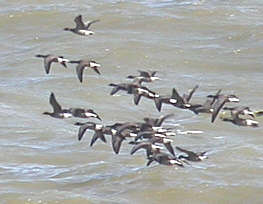
|
|
SHELDUCK Tadorna tadorna
Corton - 6th (7 N), 9th (4 S), 10th (3 S).
Kessingland - 2nd (1 S), 3rd (1 S), 6th (4 N), 7th (6 N, 3 S), 8th (4 S), 10th (12 S), 11th (1 N, 7 S), 12th (2 N, 15 S), 14th (2 S), 15th (4 S), 19th (1 N, 1 S), 23rd (1 N), 24th (4 S), 26th (1 S), 29th (6 S), 30th (6 N, 22 S), 31st (2 S, 11 o.s.).
Ness Point - 30th (5 S).
WIGEON
Anas penelope
Corton - 5th (5 S), 6th (67 N, 12 S), 9th (9 S).
Kessingland - 1st (8 S), 2nd (7 S), 3rd (1 N), 6th (7 N,
27 S), 7th (67 N), 8th (6 N, 36 S), 10th (20 N, 42 S), 11th (11 N, 24
S), 12th (22 S), 13th (20 N, 2 S), 14th (17 S), 15th (1 N, 11 S), 16th
(1 N, 3 S), 17th (3 N), 18th (31 N), 19th (70 N, 15 S), 20th (30 N),
21st (4 S), 25th (15 S), 27th (6 S), 29th (23 S),
30th (28 N, 12 S), 31st (13 N, 73 S, 11o.s.).
TEAL
Anas crecca
Lowestoft - 3rd (22 S).
Corton - 5th (22 N, 2 S), 6th (7 N, 1 S).
Kessingland - 1st (1 S), 2nd (3 N, 11 S), 3rd (45 S),
4th (3 S), 5th (6 S), 6th (3 N, 22 S), 7th (3 N, 7 S), 8th (4 N, 24
S), 9th (12 S), 10th (28 S), 11th (4 N), 12th (19 S), 13th (2 N), 16th
(1 N, 2 S), 17th (1 N), 18th (6 N, 10 S), 19th (9 N, 10 S), 20th (1
S), 21st (7 S), 22nd (4 S), 27th (1 S), 28th (5 S), 30th (2 N, 1 S),
31st (1 N, 6 S).
GADWALL Anas strepera
Noted past Kessingland on the 14th (3 S), 18th (2 S) and 29th (1
N).
PINTAIL Anas acuta
Seen at Kessingland 6th (2 N) and Corton 6th (11 N).
SHOVELER Anas clypeata
Noted past Kessingland on the 1st (4 N) and 21st (10 S). Twelve were
on Leathes Ham on the 26th.
TUFTED DUCK Aythya fuligula
Noted past Kessingland on the 2nd (1 S), 8th (2 S), 15th (1 S),
16th (3 S), 30th (3 N), 31st (5 S).
COMMON EIDER Somateria mollissima
Corton - 6th (7 male N).
Gunton - 31st (4 S).
Kessingland - 6th (1 S), 8th (1 N), 9th (5 N), 11th (19
N), 12th (3 N, 2 S), 16th (1 N), 21st (3 N), 31st (21 N).
COMMON SCOTER Melanitta nigra
Corton - 5th (2 N), 6th (50 N).
Ness Point - 6th (4 N), 8th (4 S), 20th (10 S),
21st (2 S), 23rd (2 S), 27th (2 S).
Kessingland - 1st (6 S, 13 o.s.), 4th (4 N), 5th (1 N, 7
S), 6th (15 N, 2 S), 7th (6 N, 57 S, 5 o.s.), 8th (24 N, 32 S, 20 o.s.),
9th (3 N), 11th (2 N, 2 S, 20 o.s.), 12th (3 S), 13th (8 o.s.), 14th
(1 S), 16th (1 S), 17th (5 N, 2 S, 4 o.s.), 18th (3 N, 19 S), 19th (3
N, 34 S, 1 o/s), 20th (61 N, 14 S, 4 o/s), 21st (3 N, 14 S), 23rd (1
N, 2 S), 24th (3 N), 25th (2 N), 26th (6 N, 6 S), 27th (1 S), 28th (5
N), 29th (12 N, 28 S), 30th (9 N, 15 S, 25 o.s.), 31st (47 N, 83 S,
4 o.s.).
VELVET SCOTER Melanitta fucsa
Noted at Kessingland on the 6th (1 S), 12th (2 S), 14th (3 N), 22nd
(6 S), 23rd (4 S), 24th (1 S), 29th (1 S), 31st (5 N).
GOLDENEYE Bucephala clangula
One female south, then north, with two Teal at Corton on the 5th.
Also noted past Kessingland on the 29th (4 S), 30th (3 S), 31st
(2 S).
RED-BREASTED MERGANSER Mergus serrator
Corton - 6th (7 N), 7th (1 N).
Ness Point - 6th (5 N).
Kessingland - 6th (8 N), 7th (2 N), 8th (2 N, 2 S), 11th
(2 S), 12th (4 N, 3 S), 15th (1 S), 16th (2 N, 1 S), 21st (4 S), 30th
(1 N, 3 S), 31st (20 S).
HONEY BUZZARD Pernis apivorus
One flew north over Gunton late morning on the 13th.
MARSH HARRIER Circus aeruginosus
One female flew south over the Birds Eye Factory at Ness Point on
the 16th.
HEN HARRIER Circus cyaneus
One ringtail came in off the sea at Ness Point at 9:25 on the 27th
then headed north.
MERLIN Falco columbarius
A female was watched flying in off the sea at Corton at 13:16 on
the 6th. A female was seen twice at Corton New Sewage Works on
the 9th. On the second occasion it successfully snatched a Linnet Carduelis
cannabina from a feeding flock then headed west across the A12 to
find somewhere quiet to eat it. One flew south over the North Denes
on the 13th.
HOBBY Falco subbuteo
One was seen at Corton New Sewage Works on the 9th. Further inland
one was at Mutford on the afternoon of the 10th.
OYSTERCATCHER Haematopus ostralegus
Noted past Ness Point on the 3rd (2 S), 9th (1 S).
GOLDEN PLOVER Pluvialis apricaria
One was on Lowestoft North Denes on the 13th.
GREY PLOVER Pluvialis squatarola
One flew south past Kessingland on the 5th.
LAPWING Vanellus vanellus
One flew in from the sea at Lowestoft North Denes on the 13th, and
48 were at Corton on the same day.
KNOT Calidris canutus
One was at Ness Point on the 23rd.
SANDERLING Calidris alba
One flew south past Ness Point on the 27th.
PURPLE SANDPIPER Calidris maritima
One was at Ness Point on the 6th with two there on the 7th.
DUNLIN Calidris alpina
Three flew north at Corton on the 6th. One was feeding on
Lowestoft North beach on the 8th. Four were noted southbound past Ness
Point on the 27th.
Noted past Kessingland on the 16th (12 S), 25th (8 S), 27th (8 S), 29th
(6 S), 30th (4 S).
JACK SNIPE Lymnocryptes minimus
This has been a bumper autumn for this species. Following the two seen
in September, singles were flushed at Corton on the 3rd, Gunton on the
6th and 19th, and Pakefield on the 7th.
WOODCOCK Scolopax rusticola
An excellent month for Woodcocks with eleven recorded so far. Singles
were flushed from clifftop fields at Corton on the 6th, and at Gunton
on the 11th, 12th and 21st with one off the sea on the 23rd. Seven were
seen on the 19th with birds flushed at Hopton (1), Corton (2), Gunton
(1), Lowestoft North Denes (1) and two arrived off the sea at Gunton.
One was seen in flight twice at Corton New Sewage Works on the 30th.
CURLEW Numenius arquata
Corton - 6th (5 N), 9th (2 N).
Ness Point - 6th (2 N), 24th (2 S), 30th (1 S).
Kessingland - 4th (1 S), 5th (2 N), 6th (3 S), 7th (2 N),
8th (1 N), 9th (1 S), 11th (1 S), 13th (1 S), 21st (2 S), 24th (2 S),
25th (1 S), 29th (2 S), 30th (4 N).
TURNSTONE Arenaria interpres
Forty one were at Ness Point on the 19th. Six were in the gull roost
field at Burnt Hill Lane, Carlton Colville on the 20th.
GREAT SKUA Catharacta skua
Corton - 6th (1 S), 7th (1 S).
Ness Point - 15th (1 N).
Kessingland - 4th (1 N), 5th (1 S), 6th (1 N), 15th (1
S), 16th (1 S).
POMARINE
SKUA Stercorarius pomarinus
At 14:15 on the 1st a juvenile flew north past Kessingland about one
kilometre from the beach and 8th (1 N). An immature attacked a Herring
gull less than 50 metres from the beach at Kessingland on the 24th.
It then sat on the sea washing and preening for 5 minutes before flying
north. Two were loitering offshore at Corton on the 5th. One north at
Ness Point on the 15th. Two immatures flew north at Kessingland on the
25th.
ARCTIC SKUA Stercorarius parasiticus
Corton - 5th (1 N, 1 S).
Lowestoft - 6th (1 S), 15th (2 N), 23rd (3 N). One was
chasing gulls over Lowestoft North Beach on the 23rd before continuing
north.
Kessingland - 3rd (1 N, 1 o.s), 6th (5 N, 5 S), 7th (1
o.s.), 8th (2 N), 11th (1 N), 15th (1 N, 1S), 16th (1 S), 20th (1 N),
22nd (1 N), 24th (1 N), 25th (1 N), 29th (1 N).
LONG-TAILED SKUA Stercorarius longicaudus
Continuing the excellent run this autumn individuals flew south past
Kessingland on the 5th and at 10:05 on the 7th.
| MEDITERRANEAN GULL Larus melanocephalus | |
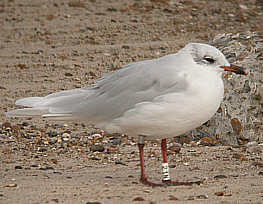
|
One
second-winter bird flew north along the coast at Corton on the
6th and 7th. The white ringed bird 21N has returned to Lowestoft
for its sixth winter, it was ringed as a nestling in the Netherlands
in 1997 and has spent each winter since then in Lowestoft and
was present on the North Beach on the 23rd and 24th. |
LITTLE
GULL Larus minutus
Corton - 6th (7 N), 7th (6 N), 30th (1 S).
Ness Point - 6th (9 N), 10th (1 S), 15th (50 N), 27th
(1 N).
Kessingland - 2nd (2 N), 6th (38 N, 1 S), 7th (12 N, 3
S), 8th (110 N, 1S), 9th (5 N), 10th (3 N, 5 S), 11th (5 N, 6 S), 12th
(1 N, 1 S), 13th (30 N, 1 S), 14th (7 N), 15th (14 N, 1 S), 16th (5
N, 2 S), 17th (4 N, 1 S), 19th (2 N), 20th (75 N), 21st (2 N, 2 S),
22nd (1 N), 24th (22 N), 25th (4 N), 29th (100 N), 30th (31 N, 4 S),
31st (4 N).
YELLOW-LEGGED GULL Larus michahellis
An adult and a third winter bird were in the gull roost at Burnt
Hill Lane, Carlton Colville on the 20th.
KITTIWAKE Rissa tridactyla
Kessingland - 6th (27 N), 9th (3 N), 15th (42 N), 17th (3
N), 19th (1 S), 21st (1 S), 23rd (7 N, 1 S), 26th (2 N, 18 S), 27th
(30 N), 29th (3 N), 30th (5 N).
SANDWICH
TERN Sterna sandvichensis
Corton - 5th (5 S), 6th (4 N).
Kessingland - 1st (1 S), 2nd (5 S), 3rd (20 S),
6th (3 S), 7th (1 N), 13th (1 S), 16th (1 S), 30th (1 S).
COMMON TERN Sterna hirundo
Noted past Kessingland on the 2nd (3 S), 4th (4 N), 7th (1 N).
GUILLEMOT Uria aalge
Four flew north past Corton on the 5th and 6th, with four also past
Ness Point on the 6th. Larger numbers are no doubt present but the vast
majority of the auks passing at present are doing so very far offshore,
so positive identification can only be made on the tiny fraction that
venture closer in. One swam south close inshore at Ness Point on the
20th.
RAZORBILL Alca torda
One flew north close inshore past Corton on the 5th before settling
on the sea. Also on the 5th one was feeding close inshore at Kessingland.
PUFFIN Fratercula arctica
One flew north at Corton on the 6th.
AUK Sp. Alcidae
Corton - 5th (32 N, 4 S), 6th (50 N).
Ness Point - 6th (9 N).
Kessingland - 2nd (3 o.s.), 3rd (2 N, 1 S), 4th (15 N), 5th
(83 N, 5 S), 6th (344 N, 2 S), 7th (54 N, 1 S), 8th (22 N), 9th
(9 N), 10th (3 N), 13th (1 N), 15th (1 N, 1 S), 16th (3 N, 18S), 17th
(17 N, 3 S), 18th (5 N, 2 S), 19th (6 N), 20th (14 N), 22nd (6 N, 1
S), 23rd (26 N, 1 S), 24th (37 N, 3 S, 1 o.s), 25th (2 N), 26th (1 N),
27th (2 N), 29th (2 N), 30th (10 N, 1 S), 31st (3 N).
TURTLE DOVE Streptopelia turtur
One was with Wood Pigeons Columba palumbus at Corton New
Sewage Works on the 6th.
RING-NECKED PARAKEET Psittacula krameri
One was being chased by a Black-headed Gull at Pakefield on the
3rd.
LITTLE OWL Athene noctua
One very confiding individual was along Corton disused railway line
on the 30th.
TAWNY OWL Strix aluco
One was roosting in Gunton Woods on the morning of the 24th.
LONG-EARED OWL Asio otus
One was present for a short time in Sparrows Nest Park on the afternoon
of the 18th.
| SHORT-EARED OWL Asio flammeus | |
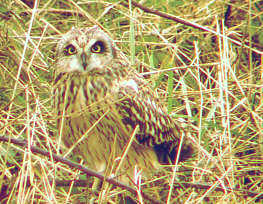 |
A
recently arrived migrant was flushed from the cliff face at Corton
on the 12th as the observers peered over the edge to look for
a silent pipit. We are not sure whether the birder or the bird
got the biggest surprise! It flew a short distance and then sat
on a lump of earth in an adjacent field for a few minutes before
being chased off by a Common Gull Larus canus. One
photographed in the old MoD radar compound at Corton on the 13th
was possibly the previous days bird. |
| One also flew south offshore past Kessingland on the 21st. Looks like it could be a bumper winter for Short-eared Owls!!! Picture - Andrew Easton. |
KINGFISHER Alcedo
atthis
One was seen along Lake Lothing on the 26th, due to the very high tide
it was perched on the fence next to the submerged footpath.
SHORE
LARK Eremophila alpestris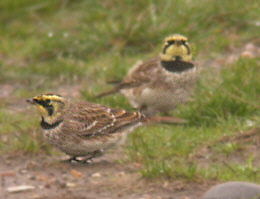
|
|
SWALLOW Hirundo
rustica
Three flew north at Gunton Beach on the 13th, and two more were
there on the 16th. One was at Corton on the 19th. Twelve were still
present at St. Olaves on the 21st. Three flew south at Gunton
on the 31st.
HOUSE MARTIN Delichon urbica
Seen over Lowestoft 16th (3), Kessingland 16-17th (2) and Corton
19th (2), 26th (1).
ROCK PIPIT Anthus petrosus
One was at Ness Point on the 5th, with three there on the 6th. One was
feeding around puddles on Lowestoft North Denes on the 21st.
YELLOW WAGTAIL Motacilla flava
One was on Lowestoft North Denes on the 5th, and two were at Pakefield
on the 7th.
| GREY WAGTAIL Motacilla cinerea | |

|
Noted
at Lowestoft 1st (1 S), 8th (1), 10th (1), 11th (1), 12th (1),
13th (1), 19th (1), 20th (1), 21st (2); Gunton 3rd (1 S), 12th
(1); Corton 6th (1), 12th (1), 13th (2), 19th (2), 20th (2), 21st;
Kessingland Sluice 7th (2), 10th (1), 18th (2); Mutford 16th (2).
The bird to the left was feeding around the pool in Corton Woods
on the 13th where two were present on the 20th. |
| It is interesting to note that this species has been added to the Amber List of species with medium conservation concern following a moderate (25-49%) decline in UK breeding population over the last 25 years (BTO Bird News 242). By contrast in our area it seems to be on the increase. Formerly we only really expected to see them in the winter, now they are even breeding locally. Picture - Tim Brown. |
ROBIN
Erithacus rubecula
This species doesn't often figure in our news pages but large numbers
of migrants have arrived with the thrushes recently and they seemed
to be literally everywhere on the 12th. Still present in good numbers
on the 19th.
REDSTART Phoenicurus phoenicurus
One along Gunton disused railway line on the 10th, two at Corton New
Sewage Works on the 12th and two along the clifftop at Gunton on the
13th may turn out to be some of the last of 2002.
BLACK REDSTART Phoenicuros ochruros
A female was in coastal gardens at Kessingland on the 5th, and one
was in Kirkley Cemetery on the 13th.
NORTHERN WHEATEAR Oenanthe oenanthe
Noted at Corton 2nd (2), 3rd (3), 4th (1); Lowestoft North Denes 2nd
(2), Pakefield 6th (1), 18th (1).
STONECHAT
Saxicola torquata
Noted at Gunton Beach 3rd (4), 5th (1), 13th (1), 29th (1); Corton 3rd
(2), 5th (3), 13th (1), North Denes 16th (1), Carlton Marshes 19th (2).
BLACKBIRD Turdus merula
Very large numbers of migrants have been in evidence recently, particularly
since the 10th. Still present in large numbers on the 19th and some
were still arriving off the sea at dusk. Good numbers were again
in evidence on the 30th following an overcast night when several flocks
of thrushes could be heard in flight over the town. More were calling
in flight as they passed over the town on the evening of the 30th.
FIELDFARE Turdus pilaris
At least fifteen were along Gunton disused railway track on the
16th. One was in St Margarets Churchyard, Lowestoft on the 19th, with
ten at Corton on the dame date. A couple of flocks totalling 40 were
watched arriving off the sea at Lowestoft and Corton on the 21st. A
party of eight were watched arriving off the sea at Gunton on the 23rd.
Five new arrivals were seen at Corton on the 30th, and several large
flocks were present at Haddiscoe Marshes, Norfolk the same day. Several
more were heard calling as they passed over the town in the evening.
SONG THRUSH Turdus philomelos
Good numbers were noted early in the month with many singletons seen
arriving off the sea. Twenty were at Pakefield on the 7th. There was
a notable influx on the 10th, 11th and 12th. 15 were together in Sparrow's
Nest Gardens with several others elsewhere. c150 were noted along coastal
Lowestoft on the 10th, but this was no doubt a conservative count and
considerable numbers were present throughout our area on the 12th. Large
numbers continued to arrive up to the 19th at least, some could be heard
calling as they passed over the town on the evening of the 30th along
with numerous other thrushes.
REDWING Turdus iliacus
One was along Gunton disused railway line on the 3rd, and later that
night two or three were calling overhead over Lowestoft. On the
6th noted at Gunton (5), Corton (2) and Mutford (30+). Two were
at Pakefield on the 7th. Arrived in good numbers on the 10th, 11th and
12th along with Song Thrush and Blackbird. c150 were noted along coastal
Lowestoft. Large numbers continued to arrive up to the 21st where several
small flocks were watched arriving off the sea at Lowestoft and Corton.
As normal these flocks continued high inland. Many were heard passing
over the town on the evenings of the 29th and 30th. One wonders what
cripplers are arriving with them, just how many Black-throateds arrive
every autumn never to be found???
RING OUZEL Turdus torquatus
Gunton has proved to be the hotspot for this species so far this month.
Two 1st winter/female birds were along the disused railway line there
on the 7th. Single males were at Gunton Dunes on the 8th to 13th. Two
more males were on Dip Farm Golf Course and railway line, Gunton on
the 11th to 13th. One was along Corton disused railway line on the 13th.
Four were along Gunton disused railway track on the 16th, with one still
present on the 17th Two were in Sparrows Nest Park on the 16th.
REED WARBLER Acrocephalus scirpaceus
Singles were noted in Warrenhouse Wood 12th and 13th; along Gunton disused
railway track 12th, at Kessingland also on the 12th, Gorleston 14th
(1) and at Corton on the 16th.
DARTFORD
WARBLER Sylvia undata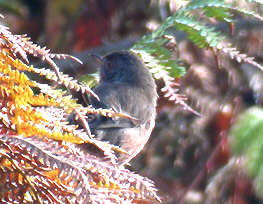
|
The
bird first seen on September 28th was seen at Gunton Beach up to the
month end. Like many Dartford Warblers, this individual can often
be found accompanying stonechats when they are also present. |
GARDEN WARBLER Sylvia borin
A late bird was present at Gorleston golf course on the 21st.
BLACKCAP
Sylvia atricapilla
Seen at Gunton 5th (1), 9th (1), 10th (3), 12th (3+), 13th (2);Pakefield
7th (2); Corton 9th (1), 12th (3+), 13th (10+), 30th (2); Kensington Gardens
21st (2).
CHIFFCHAFF Phylloscopus collybita
Small numbers had arrived throughout our area on the morning of the
12th, an encouraging sign after a complete absence for a while. Five were
in Lowestoft Cemetery on the 14-19th. Singles were at Corton and
Gunton on the 19th and 21st, and one was at Corton on the 26th and 30th.
YELLOW-BROWED WARBLER Phylloscopus inornatus
One seen at the north end of Gunton disused railtrack on the 7th was Lowestoft's
fourth of the autumn.
| FIRECREST Regulus ignicapillus | |
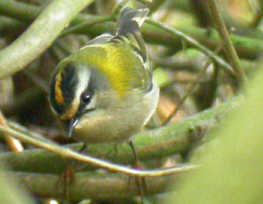
|
An
incredible 49 have been recorded this month, the most recent
in Sparrow's Nest Gardens, Lowestoft on the 24th. Mid-month saw a
major national influx with a peak around the 13th where Landguard
Point, south Suffolk held 21. The scale of the influx was obviously
huge and hundreds of birds must have been involved along coastal Suffolk.
The individual pictured left was one of two present at Corton disused
railway line on the 9th. Good numbers of Goldcrests arrived at the
same time. |
PIED
FLYCATCHER Ficedula hypoleuca
The last record of the autumn concerned one at Gorleston on the 14th.
MARSH TIT Parus palustris
One in Belle Vue Park on the 20th was an unexpected find for this site.
COAL TIT Parus ater
In addition to the regular birds in Belle Vue Park two or three were
with roving tit flocks at Gunton on the 12th. It seems likely the latter
may include migrants from the continent as they are not particularly common
away from the Belle Vue / Sparrows Nest area around here.
JAY Garrulus glandarius
A notable influx occurred in the early part of the month. Eight were
seen together at Corton New Sewage Works on the 6th, with a further flock
of eight flying north over Gunton disused railway line on the 7th. Small
groups were still present throughout our area on the 30th.
JACKDAW Corvus monedula
One individual with a partial pale collar was at the gull roost in Burnt
Hill Lane, Carlton Colville on the 20th. It was not quite as well marked
as the Scandinavian type bird seen in the same place last winter.
| GREAT GREY SHRIKE Lanius excubitor | |
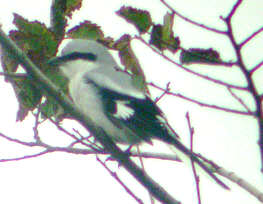 |
One
was discovered along Gunton disused railway line on the 12th, it subsequently
ranged around the adjacent Golf Course and onto the clifftops on the
opposite side of the coast road. |
CHAFFINCH
Fringilla coelebs
A flock of twenty arrived off the sea on the 7th at Ness Point. Another
flock of at least 30 arrived off the sea at Gunton on the 12th, and increased
numbers were noted at Corton the same day.
BRAMBLING Fringilla montifringilla
The first of the month involved a fly-over at Burnt Hill Lane, Carlton
Colville on the 7th. Good numbers followed with records from Gunton Woods
10th (15), 12th (17), 13th (100+), 19th (1), 24th (1); Lowestoft 10th (6),
11th (5), 12th (2), 13th (10), 20th (1); Kessingland 10th (1); Corton 12th
(1), 13th (15); Hopton 19th (2).
SISKIN Carduelis spinus
Not quite as common as in previous autumns. Seen at Lowestoft on the
9th (1 E), 20th (23); Arnold's Walk 13th (1 S); Corton 13th (1 N), 19th
(1 S).
REDPOLL Carduelis cabaret
Fly-overs noted at Two flew south over Warrenhouse Wood on the 13th
(2 S); Ness Point 14th (3); Corton 19th (8 N).
BULLFINCH Pyrrhula pyrrhula
Three were along Gunton disused railway line on the 12th, and a male
was at Hopton on the 19th.
REED BUNTING Emberiza schoeniclus
Noted at Corton 5th (3), 7th (1), 13th (3), 19th(1); Pakefield 7th (2);
Sparrows Nest Park 11th (1); North Denes 12th (1), 13th (2), 16th (2); Gunton
Dunes (1); Gunton disused railway line (3).
LAPLAND BUNTING Calcarius lapponicus
One was seen
and heard in flight over Corton New Sewage Works on the 3rd, initially southbound
but it then returned north about a minute later. What was possibly the same
bird flew north over the MoD on the 5th, with another sighting on the 7th.
One flew north
along Gunton Beach on the 13th.
SNOW
BUNTING Plectrophenax nivalis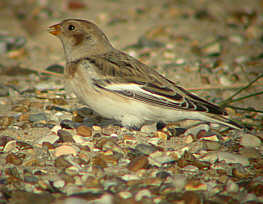
|
One
was on Lowestoft North Denes on the 19th, and two flew south together
over there on the 20th. A single bird was in the Lowestoft North Beach/ Links Road car park area on the 26th. A picture of this bird appears to the left. Picture - Andrew Easton |
|
Other
Wildlife
|
|
Several Commas Polgonia c-album and Wall Lasiommata
megera butterflies and were in evidence along Corton disused railway
line on the 3rd, and a Painted Lady Cynthia cardui was
struggling through the rain at Gunton on the 12th. |
